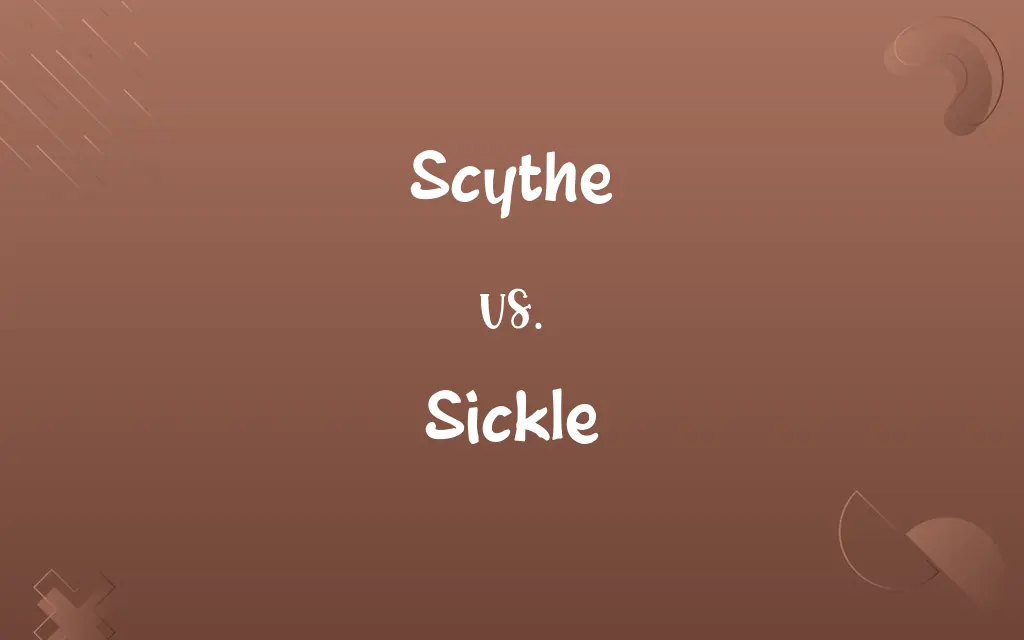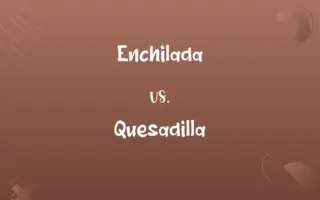Scythe vs. Sickle: Know the Difference

By Shumaila Saeed || Published on February 27, 2024
A scythe is a long, curved blade at the end of a long handle, used for mowing grass or reaping crops, while a sickle is a short-handled, crescent-shaped blade used for cutting crops.

Key Differences
The scythe is characterized by its long handle, known as a snath, which typically reaches the user's waist or shoulders, and a long, curved blade set at a right angle. This design facilitates cutting in a sweeping motion, making it efficient for mowing large fields. In contrast, the sickle is much smaller, with a short handle and a pronounced crescent-shaped blade. This compact design is suited for cutting at a closer range, ideal for harvesting specific plants or crops.
Shumaila Saeed
Feb 27, 2024
Scythes are primarily used for cutting grass or reaping crops over large areas. Their long blades and handles allow the user to stand upright, covering a wide swath with each swing. Sickles, on the other hand, are designed for more precise tasks such as harvesting grain, cutting tall grasses, or reaping crops in smaller, more manageable sections. Their small size and shape make them perfect for cutting close to the ground or in tight spaces.
Shumaila Saeed
Feb 27, 2024
Both tools have a rich history in agriculture. The scythe, with its larger blade, has been a symbol of large-scale farming and even features in folklore and mythology as a symbol of time and harvest. The sickle, predating the scythe, has ancient origins and was used in early agricultural societies. It is often associated with small-scale farming and has a symbolic presence in various cultural and political emblems.
Shumaila Saeed
Feb 27, 2024
The ergonomics of a scythe allows for a standing position, reducing strain on the back and enabling the user to work for longer periods. Its effectiveness in mowing large fields quickly made it a staple in agricultural practices before mechanized tools. The sickle, being smaller, requires the user to work in a more bent or crouched position, which can be more labor-intensive for extended periods. However, its precision and control make it indispensable for detailed harvesting work.
Shumaila Saeed
Feb 27, 2024
Today, both tools are still in use, though more commonly in traditional or small-scale farming practices. The scythe has seen variations in its design for specific types of vegetation and ergonomic comfort. Similarly, sickles have evolved, with variations in blade size and handle length, to cater to different crops and harvesting techniques.
Shumaila Saeed
Feb 27, 2024
ADVERTISEMENT
Comparison Chart
Ergonomics
Stand-up use, less back strain
Requires bending, more labor-intensive
Shumaila Saeed
Feb 27, 2024
Historical Role
Symbol of large-scale farming
Associated with early, small-scale farming
Shumaila Saeed
Feb 27, 2024
ADVERTISEMENT
Scythe and Sickle Definitions
Scythe
A tool with a long handle and a broad curved blade for cutting grass or grain.
He swung the scythe expertly, cutting a wide swath through the wheat field.
Shumaila Saeed
Jan 21, 2024
Sickle
A hand-held agricultural tool with a curved blade for harvesting crops.
The gardener wielded a sickle to cut through the thick underbrush.
Shumaila Saeed
Jan 21, 2024
Scythe
A long-handled, bladed instrument used in agriculture for cutting or mowing.
The old barn was filled with antique tools, including a rusted scythe hanging on the wall.
Shumaila Saeed
Jan 21, 2024
Sickle
A small, crescent-shaped blade on a short handle, used particularly in reaping.
He carefully harvested the ripe barley with a sharp sickle.
Shumaila Saeed
Jan 21, 2024
Scythe
An agricultural hand tool for cutting vegetation, typically grass or grain.
As the sun set, the silhouette of a man wielding a scythe could be seen in the meadow.
Shumaila Saeed
Jan 21, 2024
ADVERTISEMENT
Sickle
An ancient farming tool with a curved blade for manual harvesting.
The archaeologists found a bronze sickle, indicating early agricultural practices in the region.
Shumaila Saeed
Jan 21, 2024
Scythe
A manual tool comprising a long, curved blade fixed at an angle to a long handle.
He sharpened the blade of the scythe before starting his day in the fields.
Shumaila Saeed
Jan 21, 2024
Sickle
A traditional implement for cutting crops or grass close to the ground.
They used sickles to cut the clover, working efficiently through the small field.
Shumaila Saeed
Jan 21, 2024
Scythe
A farming implement used traditionally for mowing grass or reaping crops.
The farmer used a scythe to harvest the barley, moving rhythmically across the field.
Shumaila Saeed
Jan 21, 2024
Sickle
A short-handled farming tool with a semicircular blade, used for cutting grain or tall grass.
She used a sickle to neatly trim the edges of the wheat field.
Shumaila Saeed
Jan 21, 2024
Scythe
An implement consisting of a long, curved single-edged blade with a long handle, used for mowing or reaping.
Shumaila Saeed
Jan 14, 2024
Sickle
An implement having a crescent-shaped blade attached to a short handle, used for cutting grain or tall grass.
Shumaila Saeed
Jan 14, 2024
Scythe
An instrument for mowing grass, grain, etc. by hand, composed of a long, curving blade with a sharp concave edge, fastened to a long handle called a snath.
Shumaila Saeed
Jan 14, 2024
Scythe
(historical) A scythe-shaped blade attached to ancient war chariots.
Shumaila Saeed
Jan 14, 2024
Sickle
(agriculture) An implement having a semicircular blade and short handle, used for cutting long grass and cereal crops.
Shumaila Saeed
Jan 14, 2024
Scythe
An instrument for mowing grass, grain, or the like, by hand, composed of a long, curving blade, with a sharp edge, made fast to a long handle, called a snath, which is bent into a form convenient for use.
The sharp-edged scythe shears up the spiring grass.
Whatever thingThe scythe of Time mows down.
Shumaila Saeed
Jan 14, 2024
Sickle
(transitive) To deform (as with a red blood cell) into an abnormal crescent shape.
Shumaila Saeed
Jan 14, 2024
Sickle
(intransitive) Of red blood cells: to assume an abnormal crescent shape.
Shumaila Saeed
Jan 14, 2024
Scythe
To cut with a scythe; to cut off as with a scythe; to mow.
Time had not scythed all that youth begun.
Shumaila Saeed
Jan 14, 2024
Scythe
An edge tool for cutting grass; has a long handle that must be held with both hands and a curved blade that moves parallel to the ground
Shumaila Saeed
Jan 14, 2024
Sickle
A reaping instrument consisting of a steel blade curved into the form of a hook, and having a handle fitted on a tang. The sickle has one side of the blade notched, so as always to sharpen with a serrated edge. Cf. Reaping hook, under Reap.
When corn has once felt the sickle, it has no more benefit from the sunshine.
Shumaila Saeed
Jan 14, 2024
Sickle
An edge tool for cutting grass or crops; has a curved blade and a short handle
Shumaila Saeed
Jan 14, 2024
Repeatedly Asked Queries
Is a sickle still used today?
Yes, sickles are still used, especially in traditional or small-scale farming.
Shumaila Saeed
Feb 27, 2024
What makes a scythe efficient for farming?
Its long handle and blade allow for wide, efficient swings, reducing labor over large areas.
Shumaila Saeed
Feb 27, 2024
Is operating a scythe physically demanding?
While less back-straining than a sickle, using a scythe can still be physically demanding.
Shumaila Saeed
Feb 27, 2024
Can a scythe cut tall grass?
Yes, a scythe is effective for cutting tall grass.
Shumaila Saeed
Feb 27, 2024
Why do sickles have a curved shape?
The curved shape of sickles helps in efficiently cutting through crops and grass.
Shumaila Saeed
Feb 27, 2024
How has the design of the scythe evolved?
Scythes have evolved for specific vegetation types and ergonomic comfort.
Shumaila Saeed
Feb 27, 2024
How is a sickle different from a scythe?
A sickle is smaller with a crescent-shaped blade, used for precise cutting of crops, unlike the larger scythe.
Shumaila Saeed
Feb 27, 2024
What is the historical significance of the scythe?
The scythe symbolizes large-scale farming and has a presence in folklore and mythology.
Shumaila Saeed
Feb 27, 2024
What is a scythe used for?
A scythe is used for mowing grass or reaping crops over large areas.
Shumaila Saeed
Feb 27, 2024
What crops are typically harvested with a sickle?
Crops like wheat, barley, and rice are often harvested with a sickle.
Shumaila Saeed
Feb 27, 2024
Are there different types of sickles?
Yes, there are variations in sickles based on blade size and handle length.
Shumaila Saeed
Feb 27, 2024
Can a scythe be used for small gardens?
It's less practical due to its size and is better suited for larger fields.
Shumaila Saeed
Feb 27, 2024
Is a sickle easy to use?
It requires skill and practice, especially for efficient and safe use.
Shumaila Saeed
Feb 27, 2024
Why is the sickle a political symbol?
The sickle often represents agricultural labor and has been used in various political emblems.
Shumaila Saeed
Feb 27, 2024
How long does a scythe blade last?
With proper care, a scythe blade can last for many years.
Shumaila Saeed
Feb 27, 2024
Is it difficult to learn to use a sickle?
There is a learning curve, but with practice, it becomes easier.
Shumaila Saeed
Feb 27, 2024
Can a sickle be used for lawn care?
Yes, but it's more suited for small areas or detailed work.
Shumaila Saeed
Feb 27, 2024
How do you maintain a scythe?
Regular sharpening and proper storage are key to maintaining a scythe.
Shumaila Saeed
Feb 27, 2024
What is the best way to use a sickle?
Using a sickle involves a swinging or pulling motion close to the crop base.
Shumaila Saeed
Feb 27, 2024
Where did the scythe originate?
The scythe's origins are in agricultural societies, evolving over centuries.
Shumaila Saeed
Feb 27, 2024
Share this page
Link for your blog / website
HTML
Link to share via messenger
About Author
Written by
Shumaila SaeedShumaila Saeed, an expert content creator with 6 years of experience, specializes in distilling complex topics into easily digestible comparisons, shining a light on the nuances that both inform and educate readers with clarity and accuracy.








































































